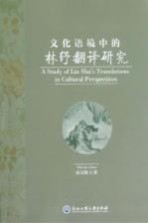
- 作 者:高万隆著
- 出 版 社:杭州:浙江工商大学出版社
- 出版年份:2012
- ISBN:9787811406290
- 标注页数:259 页
- PDF页数:269 页
请阅读订购服务说明与试读!
订购服务说明
1、本站所有的书默认都是PDF格式,该格式图书只能阅读和打印,不能再次编辑。
2、除分上下册或者多册的情况下,一般PDF页数一定要大于标注页数才建议下单购买。【本资源269 ≥259页】
图书下载及付费说明
1、所有的电子图书为PDF格式,支持电脑、手机、平板等各类电子设备阅读;可以任意拷贝文件到不同的阅读设备里进行阅读。
2、电子图书在提交订单后一般半小时内处理完成,最晚48小时内处理完成。(非工作日购买会延迟)
3、所有的电子图书都是原书直接扫描方式制作而成。
Chapter 1 Introduction 1
1.1 Lin Shu:A Controversial Figure in Chinese Translation History 3
1.2 Significance of the Research on Lin Shu 4
1.2.1 Need for Reevaluation of Lin Shu's Translations 4
1.2.2 Lin Shu,Father of China's Modern Literary Translation 6
1.2.3 Influence of Lin Shu's Translations 8
1.3 Theoretical and Empirical Contribution of the Study to Translation Studies 18
1.4 Structure of the Work 20
Chapter 2 Lin Shu'S Works Within a Target-oriented/Culture-oriented Framework 23
2.1 Target-oriented/Culture-oriented Translation Theories 23
2.1.1 Toury's Target-oriented Translation Theory 26
2.1.1.1 Translators'Main Goals 26
2.1.1.2 The Role and Function of Translation 28
2.1.1.3 Translation Strategies 28
2.1.2 Culture-oriented Translation Studies 30
2.1.3 Readers'Response and Reception Theory 34
2.2 Cultural Translation Studies in China 40
2.2.1 Target-oriented/Culture-oriented Translation Approach 43
2.2.2 Contextual Analysis 44
2.2.3 Textual Analysis 44
Chapter 3 Critical Literature Review on Lin Shu 45
3.1 Chinese Criticism 45
3.1.1 Affirmation by Lin Shu's Contemporaries 46
3.1.2 Condemnation During the May Fourth New Culture Movement 47
3.1.3 Assessment After Lin Shu's Death 52
3.1.3.1 General Reviews 52
3.1.3.2 Zheng Zhenduo's"Mr Lin Qinnan" 57
3.1.3.3 Han Guang's"Lin Qinnan" 60
3.1.4 Negative Criticism from 1949 to 1979 64
3.1.5 Revival:1980s Onwards 66
3.1.5.1 Qian Zhongshu's"Lin Shu's Translations" 66
3.1.5.2 New Critical Interest 69
3.2 Western Criticism 72
3.3 Key Issues in Dispute Concerning the Assessment of Lin Shu 79
3.3.1 Lin Shu's Thought:Conservative or Reformist? 81
3.3.2 A Pioneer or an Opponent of Modern Chinese Culture? 86
Chapter 4 Lin Shu in Cultural Context 95
4.1 Lin Shu's Translations in the Cultural Context 95
4.1.1 Lin Shu's Choice and Response 95
4.1.1.1 In Search of Similarities 97
4.1.1.2 Literary Subject Matters 99
4.1.1.3 Literary Genres 107
4.1.1.4 Literary Style and Technique 110
4.1.2 Output of Lin Shu's Translations 114
4.1.3 Lin Shu's Translation Practice 115
4.1.3.1 Joint Translation 116
4.1.3.2 Paraphrase or Free Translation 118
4.2 Case Study:Bali Chahuanii Yishi―Transfiguring Chinese Fiction 121
4.2.1 Ideological Content 122
4.2.2 Characterization 130
4.2.3 Literary Form 133
Chapter 5 Poetic Equivalence 136
5.1 Poetic Equivalence and Lin Shu 136
5.2 Spirit and Style 140
5.3 Expression in Literary Language 149
5.4 Sinicization 155
Chapter 6 Beyond Equivalence 165
6.1 Adaptation 165
6.2 Omission 169
6.2.1 To Overcome"Cultural Default" 170
6.2.2 Simplification for Succinctness 173
6.2.3 Treatment of Western Religious Materials 180
6.3 Addition 185
6.3.1 To Make up"a Perceived Void"in the Original Text 186
6.3.2 To Embellish the Original Text 188
6.3.3 To Bridge the Cultural Gap 191
6.4 Alteration 195
6.4.1 To Heighten the Readers'Impression 196
6.4.2 To Rewrite the Original Text 199
6.4.3 Intervention into Translation 205
6.5 Abridgement 212
Chapter 7 An Exemplar of Chinese Literary Translation 217
Bibliography 220
Glossary 241
List of Lin Shu's Translated Works 251
